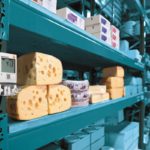Invisible to the naked eye and often hard to detect in subtle amounts, exposure to humidity can nonetheless have a big impact on a range of substances.
That is why the use of humidity data loggers is so important in a large number of environments. In residential and commercial buildings, keeping accurate tabs on humidity can be critical to ensuring the comfort and health of occupants, as well as the effectiveness of systems such as ventilation units.
Humidity is also a vital factor to measure in a range of industries that handle the storage and transportation of goods, with materials ranging from metal to wood – and everything in between – all prone to wear and deterioration from humidity.
Humidity affects different objects in different ways, so if your business is involved in the storage of any of the following materials, it pays to know what to expect.
Metals
The most obvious impact that high levels of humidity can have on common metals, such as iron, is corrosion and rust. This is not only a problem in the aesthetic sense, in the form of discoloured, flaky metal, but also from a safety perspective as corrosion can affect the structural integrity of metal.
Rusted metal can be very difficult to repair or restore to its former state, and if not stored properly, you could end up having to dispose of your affected metal products – which can incur a substantial cost.
Humidity measuring and management is also therefore an important responsibility for entities such as museums, which may be storing valuable metal artefacts from centuries ago. If humidity is not monitored, these priceless, irreplaceable objects can be damaged and lost forever.
Wood
An important point to consider is that most wood contains some level of moisture content. If this is managed at the right level, it does not present a major issue. However, varying levels of humidity can affect the moisture content and cause the wood to expand or contract – and thus affect its strength and structural integrity.
Excessive humidity can visibly damage wood, causing cracks to appear, for instance. Another unique challenge with wood is that even moderately high levels of humidity can encourage mould, mildew and fungus growth – an unsightly problem that has the potential to ruin all sorts of wood products.
Paper
For organisations such as museums, libraries and archives that store large volumes of fragile paper, such as old records and books, keeping an eye on humidity is key. High humidity can wreak havoc on a range of paper products, causing irrecoverable damage.
Like wood, paper is directly affected by the amount of water in the air in its immediate surroundings. This means paper also shrinks or expands depending on its moisture content and the relative humidity of the atmosphere. Repeated movement and activity on the paper’s surface can cause cracking and other effects on its texture.
Plants
As living organisms highly reliant on the gaseous makeup of the immediate atmosphere, humidity significantly affects plants – making it an important consideration for gardens, both commercial and recreational, and other organisations that store or transport plants.
In highly humid environments, plants may not be able to release water as efficiently into the air – meaning they can’t take up more water from their roots, thus stunting their growth. On the other side of the scale, excessively dry air can have a similarly devastating effect on the health of plants.
Humidity is evidently a serious consideration for a range of businesses, and constant measurement is the most effective way to ensure it doesn’t have a damaging effect. Tools such as the testo 610 pocket-sized air humidity measuring instrument can play a vital role in ensuring product safety and quality.









 Reduce cooking oil costs while ensuring quality
Reduce cooking oil costs while ensuring quality Expert knowledge on CO2 monitoring
Expert knowledge on CO2 monitoring Refrigeration knowledge - in 3 modules
Refrigeration knowledge - in 3 modules



